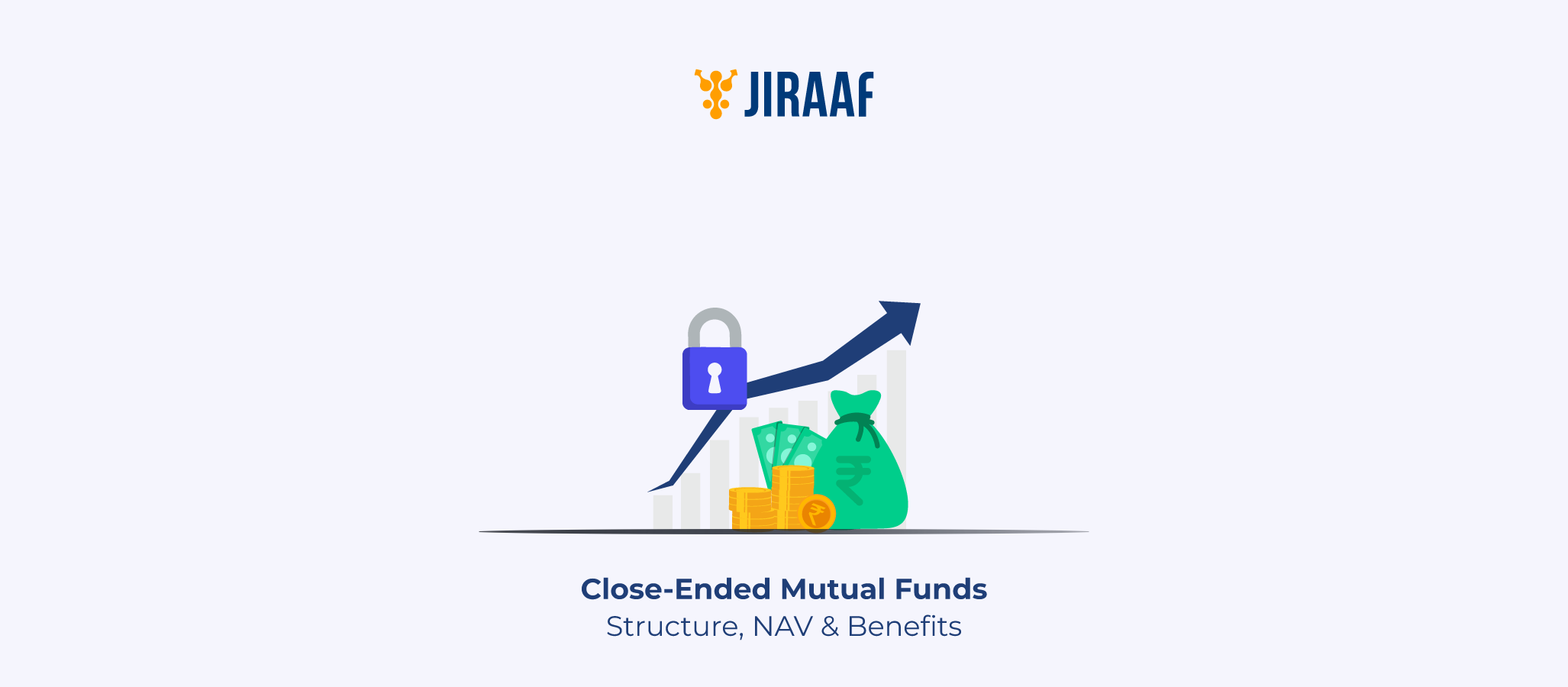Investing in mutual funds is a bit like selecting a travel itinerary; some allow you to join and exit at any moment (open-ended), while others set your itinerary and timing in advance, also known as a close-end mutual fund. Consider purchasing a non-refundable tour package with set start and end dates; you are unlikely to join the trip in the middle or leave early, as everything is well-organized. Likewise, close-end mutual funds have a set maturity period and investment window. Wondering how they operate and if they’re a good fit for you? Let’s break it down.
What is a Close-Ended Mutual Fund?
A close-ended mutual fund is an equity or debt instrument that requires a fund house to issue a certain number of units upon its launch. You can no longer buy or redeem units of the close-ended mutual fund after the NFO (new fund offer) period has finished.
A fixed number of fund units is traded on stock exchanges for close-ended mutual funds. Compared to mutual funds, close-ended funds function more like exchange-traded funds (ETFs). Like stocks, they are traded on the open market after being issued through an NFO to raise money. The net asset value (NAV) determines the fund’s value, while supply and demand determine its real price. As a result, it might trade for a greater or lesser amount than its actual value.
Close-ended funds may therefore trade at prices higher or lower than their NAVs. Close-ended fund units are accustomed to being traded on the market by brokers. Close mutual funds have a specified maturity period and trade at a premium to the value of their underlying assets.
Units could be sold on the open market by investors looking to withdraw from the plan. However, it could also take some time and effort to find a seller for the price you want because of the close-ended structure and limited liquidity. The opportunity to buy back the units after a predetermined time period is provided by certain close-ended funds. Additionally, it gives you a way out before the maturity date.
How Do Close-Ended Mutual Funds Work?
As an investor, you buy a unit of this plan at a specific price once the asset management company (AMC) sets up an NFO. No new investors are allowed to join the plan at the end of the NFO term. Additionally, you have no way to withdraw your money before the scheme’s maturity. This plan ends when it matures, and you receive your money at the NAV on that day. Therefore, you can exchange the units on stock markets if you want to withdraw from this plan before the end of its maturity period.
To raise funds, a close-ended mutual fund initiates a new fund offer (NFO). Units are awarded to you if you contribute money to the mutual fund. Following publication, you can trade the units in the secondary markets based on supply and demand circumstances. A close-ended mutual fund does not issue new units or buy back existing ones, as the name implies. A close-ended fund issues its shares just once. The only way to get into this fund later on is to buy some of those existing shares on the open market.
NAV in Close-Ended Mutual Funds: How It’s Calculated
The net asset value (NAV), which is the per-unit value of the fund’s underlying assets less its liabilities, is an important indicator for all funds, including close-end funds. It’s calculated using the following simple formula:
NAV = (Total Assets – Liabilities) / Total number of units outstanding
For instance, the NAV is ₹9.9 per share if a fund has ₹1,000 crores in assets, ₹10 crores in liabilities, and 100 crores in outstanding units.
Key Differences Between Open and Close-Ended Funds
It is quite important to understand the key difference between open and close-ended mutual funds before you narrow down an option. Let’s break it down.
| Feature | Close-Ended Funds | Open-Ended Funds |
| Liquidity | No liquidity during the lock-in period. | Highly liquid. |
| Investment Timeline | Only during NFO. | Any time even after NFO. |
| SIP Access | Not available. | Available. |
| Rupee-cost Averaging | Not applicable. | Applicable via SIPs. |
| Minimum Investment | Typically, ₹5,000. | Starts with ₹500–₹1,000. |
| NAV Calculation | Based on market demand or underlying assets. | Calculated daily. |
| Exit Options | Following lock-in through the stock exchange, if listed. | Redeem anytime at NAV. |
Pros and Cons of Investing in Close-Ended Funds
Close-ended mutual funds offer an exceptional investment structure with distinct pros and cons. Understanding these can help you decide if they align with your financial goals and if you should consider investing in them. Let’s break these down.
Advantages of Close-Ended Funds
- These funds come with a fixed-asset base since you can’t redeem them before maturity, and you can focus on long-term strategies.
- These are traded on stock exchanges; thus, the prices are solely affected by supply and demand. As a result, units may trade above NAV, and if sold at the proper time, they may even yield larger returns. Like this, you also get liquidity without relying on an AMC.
- Fund managers can focus entirely on long-term performance rather than short-term liquidity management because there is no obligation to redeem.
Disadvantages of Close-Ended Funds
- These are not as flexible. Unless you sell on the exchange, which isn’t always the best option, you can’t leave before maturity.
- The costs are not as reliable. Speculative risks could rise if market prices diverge from actual NAV, resulting in either an overvaluation or an undervaluation.
- The availability of buyers determines when to sell; if demand is limited, you may have to offer a lower price or suffer delays.
- Unlike SIPs in open-ended funds, rupee-cost averaging cannot be used during the NFO; only lump-sum investments are allowed.
Who Should Consider Investing in Close-Ended Mutual Funds?
If you can make a one-time payment for a specified investment horizon that corresponds with the scheme’s maturity, close-ended mutual funds are an ideal choice for you. These funds are appropriate for you if you have an eye towards the future and a disciplined investing strategy because they do not offer redemption until maturity. To fully understand the risk-return profile, it is essential to look into the asset allocation of the scheme as described in the offer documents.
Conclusion
Close-ended funds have the potential to be a great source of income. By now, you would know that investing in close-ended funds can be slightly tricky when it comes to liquidity. A close-end mutual fund seems to be ideal if you are a more experienced investor with a lengthy investing time horizon, a stomach for market volatility, and a diverse income portfolio.
FAQs
What is the lock-in period for close ended mutual funds?
Depending on the fund’s mandate, close-ended mutual funds normally have a lock-in period of 3 to 7 years. You cannot redeem units directly at this time, but you can trade them in stock market (if listed) following the original NFO. A minimum 3-year tenure is required by SEBI for most close-ended funds. For precise lock-in terms, always refer to the fund’s offer document.
Can I sell close ended mutual funds before maturity?
Close-ended mutual funds can be sold before they mature, but only on stock exchanges (if listed). Redeeming funds directly from the AMC is not allowed, as opposed to open-ended funds. Market demand determines liquidity, and you can see price reductions or low trade volumes.
How is NAV calculated in a close ended fund?
A close-ended fund’s net asset value or NAV is determined by subtracting its liabilities from the current market value of its assets, then dividing the result by the total number of outstanding units. As the overall value of the securities in the underlying portfolio increases or decreases, the NAV also changes.
Are close ended mutual funds risky?
Close-ended funds involve higher risks because of their dependency on fund management performance, market-driven pricing (possible NAV reductions), and restricted liquidity. There may not be enough buyers for secondary market trade, and lock-ins limit withdrawals. They do, however, provide long-term stability. Each asset class has a different level of risk; funds that prioritise equity are riskier than those that prioritize debt.
How do close ended mutual funds differ from open ended ones?
As the name implies, open-ended funds are a kind of mutual fund that allows you to enter and exit at any time. Conversely, close-ended funds are those that you can purchase during the IPO or from the stock exchange following an offer.
Discover fixed income investments with Jiraaf, a SEBI registered online bonds platform that educates and brings access to a wide array of bonds. Sign up today to explore diversified fixed income investment opportunities to support your goal-based wealth creation journey. Start investing!









